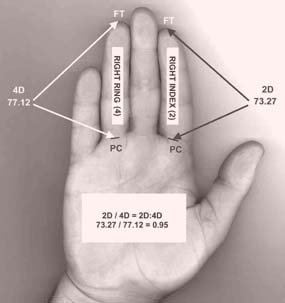|
An overview of Prof. Mannings work on digit ratio:
In a 1998 study, Manning revealed that the ratio of second to fourth digit length is "a predictor of sperm numbers" in men.
In 2000, Manning published a study called The Ratio of second to fourth Digit Length and Male Homosexuality.
There he revealed the existence of "a significant positive relationship" between 2D:4D and "exclusive homosexuality".
That same year, in a different study, Manning told of discovering great variations in "reproductive success and 2D:4D from England, Germany,
Spain, Hungary (ethnic Hungarians and Gypsy subjects), Poland, and Jamaica (women only)".
One minor finding, he said, was that "the English sample also showed that married women had higher 2D:4D ratios than unmarried women".
Topping out the year, he also predicted that "2D:4D ratio is predictive" of the following conditions: infertility, autism, dyslexia,
migraine, stammering, immune dysfunction, myocardial infarction and breast cancer.
In a 2001 study, Manning explained that "men and women with low 2D:4D are susceptible to HIV infection and Aids".
Also in 2001, he reported that professional football players had lower 2D:4D ratios than other men, and that "football players
in first-team squads had lower 2D:4D than reserves or youth team players".
In 2002, Manning published studies explaining that 2D:4D has a relationship to musical genius, and also to skiing performance.
He deduced the latter by analysing the ski-run times and finger lengths of 72 skiers, each of whom skied twice over a 200-metre slalom course.
His discovery: that "low 2D:4D was associated with fast skiing times".
In 2003, Manning reported, in separate studies, that in men, 2D:4D is "related to perceived dominance and masculinity but not attractiveness",
and that 2D:4D might be useful for predicting which preschool children will grow up to be psychopaths.
Next week we will peek at some of the other brightly blazing academic finger stars.
Marc Abrahams is editor of the monthly Annals of Improbable Research
and organiser of the Ig Nobel Prize
Related sources:
Double Digits at The Guardian
Talk to the Hand
Giving science the Finger
Finger Length (2D:4D) moderates the impact of an aggressive music video on aggression
Length of Fingers show how 7-year-old children will do at maths or English
Pointing a Finger at sports success
HANDS IN THE NEWS
|


